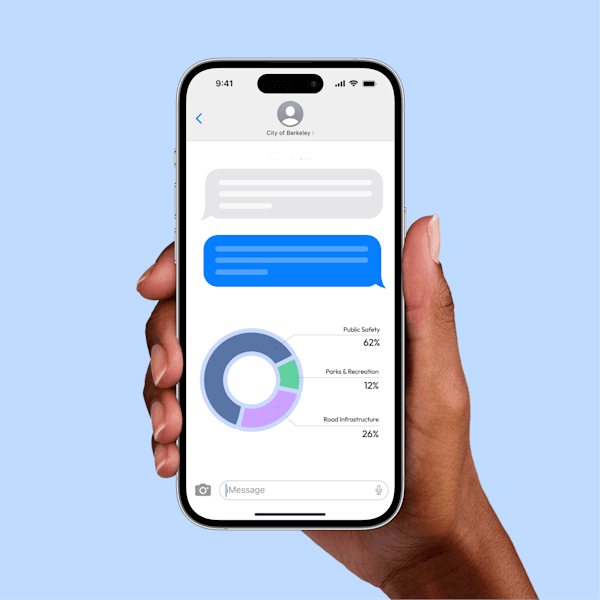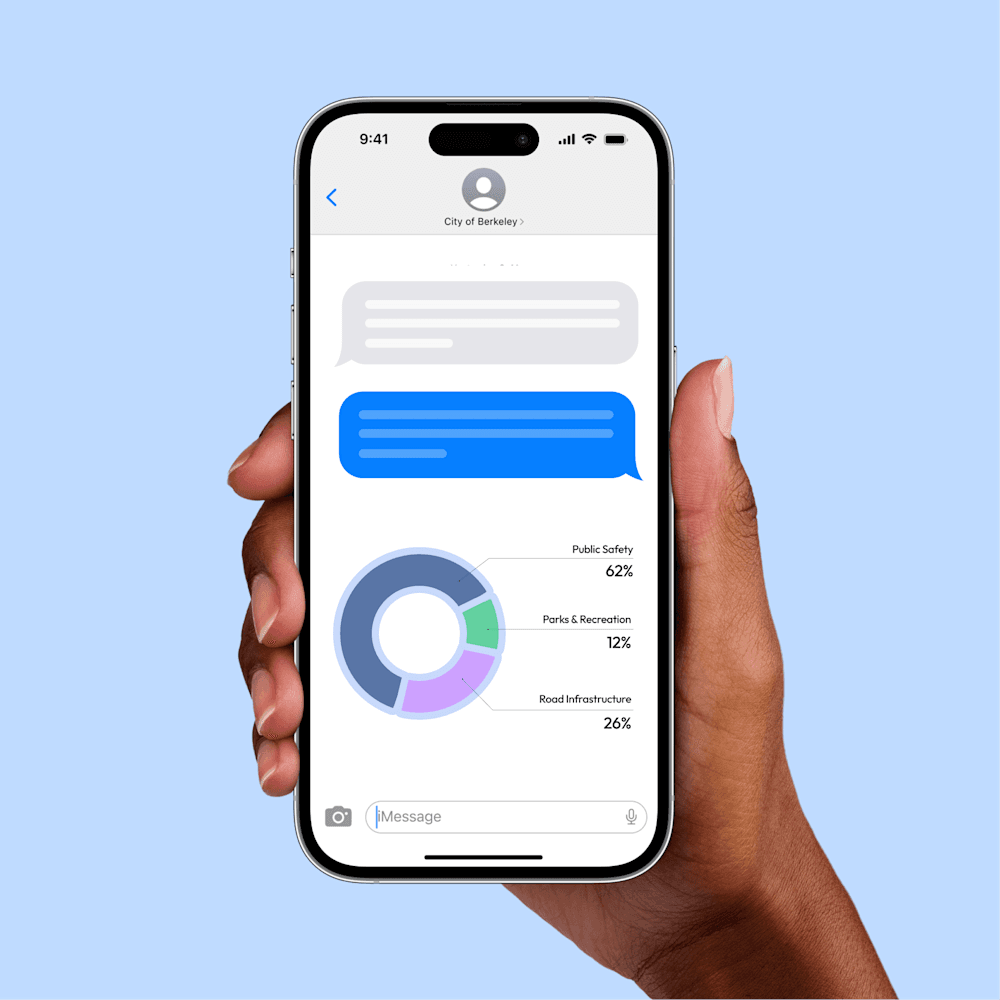
How to Conduct a Community Survey: Guide for Local Officials
Community surveys are one of the simplest and most powerful tools for understanding what your residents need and how to be a better public servant for them. They can help you make smarter decisions, reduce guesswork, and build trust, but only when they’re done at the right moments and in the right way.
In this guide, we’ll walk through how to conduct a community survey, then break down the most strategic times to run one. Whether you’re starting a new term or navigating a major issue in your community, you’ll learn when and how to survey residents effectively.
Why Your First Community Survey Should Happen Early in Your Term
If you take office without a clear understanding of constituent priorities, it’s easy to get pulled off course by the loudest voices, internal pressures, or inherited problems.
Launching a survey within your first 100 days can help you:
Set the tone for your leadership. An early survey signals that your decisions will be guided by real community needs, not assumptions or political pressure.
Establish a baseline. You need a clean snapshot of your community’s priorities before your first major decisions start shaping public perception.
Spend your political capital wisely. Every term in elected office begins with momentum. A survey helps you aim it in the right direction.
Build trust early. When you ask for feedback right away and act on it, you show constituents you’re here to listen, and that builds long-term goodwill.
If you only run one survey during your term, consider running one early on to start your time in office off right.
How to Conduct a Community Survey: 7 Steps
Learning how to conduct a community survey isn’t just about crafting good questions. It starts with choosing the right moment, defining a clear purpose, and making the process easy for residents to engage with. When you approach surveys and opinion polls this way, you collect better data, make more informed decisions, and show your community that their voices truly matter.
Step #1: Choose the Right Moment to Launch Your Survey
Timing is one of the most important parts of the survey process. Certain moments consistently generate higher engagement, better-quality responses, and more actionable insights.
Here are the most effective times to conduct a community survey, in the order they naturally occur over a term:
Early in Your Term: This is the ideal time for your first survey. It gives you clarity, direction, and buy-in early on.
Before Major Meetings, Agenda Items, or Controversial Votes: When an upcoming decision will impact a lot of people, leaders often survey citizens to get a quick temperature check before stepping into big council meetings, controversial agenda items, major hearings or public comment sessions, or community debates. It’s one of the fastest ways to ensure your decisions are grounded in real public sentiment.
Before and After Budget & Planning Cycles: Budgets reflect values, so many leaders survey their communities before budget planning sessions and public hearings, and after budget plans are finalized to check if the community is aligned with the plan.
After Major Community Events or Hot Topics: When a controversy erupts or a local issue dominates social media, surveys help you figure out whether it’s a broad concern, a neighborhood-level issue, or a misunderstanding. This can help prevent you from overreacting to noise or underreacting to real concerns.
Two to Six Months Before a Reelection Campaign: You can use surveys to understand what the community believes you’ve done well, what issues remain top of mind, and where constituents want you to focus next.
As a Recurring Quarterly or Annual Check-In: Regular community check-ins help you watch priorities shift, demonstrate transparency, measure your impact, and show constituents you’re consistently listening.
Using constituent engagement tools like GoodParty.org Serve can help you quickly complete and analyze community surveys. After your first survey with GoodParty.org Serve, you get a report filled with real quotes and top issues. Many local leaders find that to be a great time to send a follow-up survey. That first experience is a powerful proof-of-value moment, sparking recurring, data-driven engagement throughout your term.
Step #2: Define the Purpose of Your Survey
Be clear about what you want to learn.
Common reasons for launching a community survey include:
Identifying top community priorities
Gathering input before a major decision
Testing reactions to a new policy or proposal
Collecting open-ended concerns from residents
Tracking changes over time
A focused purpose keeps your survey short and your results meaningful.
Step #3: Keep Your Survey Short, Accessible, and Easy to Complete
The best community surveys respect people’s time. When surveys are concise and easy to understand, you get higher participation and better-quality data, especially from residents who don’t usually attend public meetings or respond to longer feedback requests.
To make your survey accessible:
Limit the number of questions. Ask thoughtful questions so you can gather meaningful insights without overwhelming residents.
Use simple, neutral language. Avoid jargon, acronyms, or insider terminology that could confuse or bias respondents.
Mix question types strategically. Multiple-choice questions can make analysis easy, while one or two open-ended prompts help you capture nuance and context.
Design for mobile first. Most residents will respond on their phones, so short questions and clean layouts perform best.
Provide translation or multilingual options when possible. This helps ensure the survey is inclusive of everyone in your community.
By keeping the survey short and accessible, you’re removing friction and making it more likely that residents from all backgrounds and age groups will participate.
LEARN MORE: Level up your outreach with community engagement strategies for local governments.
Step #4: Reach a Broad and Representative Slice of Your Community
Reaching the right people matters just as much as asking the right questions. Text-based surveys are one of the most effective ways to do that because they meet residents where they already are: on their phones. Since most people read and respond to texts quickly, text surveys help you collect input from a wider, more diverse group of constituents than traditional channels alone.
Launching a community survey via text allows you to:
Reach people quickly, including those who rarely open email or attend meetings
Include underrepresented voices like renters, younger residents, and working families
Improve accessibility for people with limited internet access
Make participation simple, since no downloads or accounts are required
With tools like GoodParty.org Serve, your survey is delivered directly to your constituents’ phones, minimizing friction and helping you gather more actionable feedback from the community.
You can also amplify engagement by letting residents know a survey is happening through other channels you already use, such as social media updates, your newsletter or email list, or a brief announcement during public meetings.
Step #5: Analyze the Results Thoughtfully
Once responses start coming in, the real value of a community survey comes from how you interpret the results. Good analysis helps you understand not just what people said, but why they said it and what it means for your next steps as a leader.
Here’s how to make your analysis stronger and more actionable:
Look for recurring themes. When several residents raise the same issue, even across different neighborhoods or demographics, that’s a sign it deserves attention.
Pay attention to priorities, not just complaints. Surveys often surface what people want more of, not only what they want fixed.
Identify where there’s broad agreement. Strong consensus, whether positive or negative, gives you confidence and political cover to act.
Flag areas of division or nuance. If different neighborhoods or groups respond differently, you may need targeted outreach or more context.
Use quotes to understand the “why.” Qualitative feedback adds depth to numbers and helps you understand tone, sentiment, and lived experiences.
Look for surprises. Unexpected findings often reveal blind spots, and these insights are some of the most valuable.
Connect results to the specific moment you surveyed. Budget season, a controversial vote, or a recent local issue all shape how people respond. Context matters.
Thoughtful analysis helps you make decisions that are grounded, transparent, and responsive, and it strengthens your ability to lead with clarity.
Step #6: Share What You Learned Transparently
Publishing poll results is one of the most trust-building things you can do.
A simple community survey summary report can include:
The top issues or priorities
Key themes and takeaways
A few representative quotes
What you plan to do next
It doesn’t need to be complicated. A short post, newsletter update, or slide at a public meeting goes a long way. When people can see how their input shaped your understanding, trust grows.
Step #7: Close the Feedback Loop and Plan Your Next Survey
A survey only builds trust when people can see how their input influenced your decisions. Close the loop by sharing a brief follow-up: what you learned, what you’re doing next, and how their feedback shaped your direction. Even small updates signal that you’re listening.
From there, decide when your next survey should happen, whether it’s tied to an upcoming decision, a budget cycle, or a regular quarterly check-in. Consistency turns surveys from one-off moments into an ongoing conversation with your community.
LEARN MORE: Launch your first community survey with GoodParty.org Serve to start building better communication with your constituents.
Why Community Surveys Matter
Community surveys help you govern with clarity, integrity, and confidence.
When done well, surveys:
Reveal real community priorities. They help you see what matters most across neighborhoods, age groups, and backgrounds, not just what you hear from the loudest voices.
Strengthen trust through transparency. When residents see you asking for input and sharing what you heard, they feel respected and included, and are more inclined to get involved in local government.
Prevent small issues from becoming big problems. Surveys can surface concerns early, allowing you to address them before they escalate or dominate public meetings and social media.
Help you measure impact over time. Regular surveys show whether your policies or initiatives are working, where progress is visible, and where more attention is needed.
Support equitable decision-making. Broad, accessible surveys ensure you hear from residents who don’t attend meetings or engage through traditional channels.
Turn leadership into partnership. When communities see that their voices shape decisions, they become more engaged in local problem-solving and civic life.
At their best, community surveys create a continuous feedback loop that guides your leadership and builds long-lasting trust. They help you serve your community, knowing your decisions reflect the people who rely on you most.
LEARN MORE: Explore the power of constituent engagement and why listening to your community matters.
Listening Makes Leadership Stronger
Community surveys are one of the most effective tools you have to understand what your residents need and demonstrate that you’re governing with integrity. When you ask questions early, ask often, and act on what you hear, you build a level of trust and alignment that no headline or public meeting can match.
By choosing the right moments, keeping your surveys accessible, sharing what you learn, and closing the loop, you create an ongoing conversation with your community that makes every decision clearer, smarter, and more connected to real people’s lives.
Civic tech tools like GoodParty.org Serve can make this process easier. With fast, accessible text surveys and clear, actionable reports, GoodParty.org Serve helps elected officials gather real input from their communities without needing consultants, long timelines, or complicated tools. It’s designed for leaders who want to listen deeply, respond transparently, and build trust through responsible, people-centered governance.
Photo by Jonathan Borba on Unsplash
If you’re ready to understand your community’s priorities, build stronger relationships with your constituents, and make more informed decisions from day one, launch your first survey through GoodParty.org Serve today.

